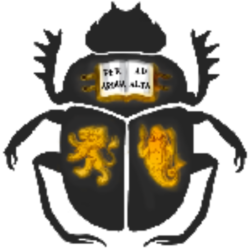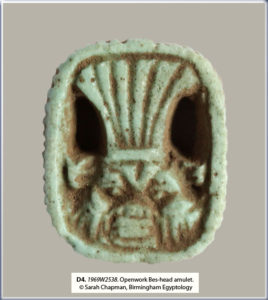Click the images to enlarge
——————————————————————————————————————————————————————————-
D. Object Labels (pdf file)
Amulets depicting the head or face of a Bes-deity can be found from the Third Intermediate Period which display a variety of different forms (Petrie amulet type 190, 1914: 41; Andrews 1994: 39). ECM117 exhibits the face of a Bes-deity fully cut out but with plumes missing due to damage through the suspension hole inserted between the head and the headdress. Further damage around the nose indicates that a hole was once inserted through for jewellery to be fitted. A large beard, or mane, can be seen skirting around the lower face through which a tongue protrudes. This gesture, as discussed above, is an aggressive symbol that was intended to scare away evil from the amulet’s wearer (Millward 2012). A protruding tongue can also be seen on 1969W2342, but in this instance the face of ‘Bes’ is moulded on a disc pendant and missing the suspension lug from the top. The reverse of this amulet is moulded in the form of a wedjat eye and may reflect a growing connection between ‘Bes’ and solar gods (Dasen 1993: 65) a circumstance likely designed to give the wearer protective and regenerative strength in either this life or the next.

Bes-head amulets were usually manufactured through a moulding technique by pressing the faience paste into a pre-fired clay shape. 1969W3740 is a large clay mould used for the shaping of these amulets, and the holes at each end would have facilitated the insertion of a tool through the paste to create the suspension hole necessary for mounting the object after firing. Occasionally the faces may have been cut and carved after moulding to produce more intricate designs, such as 1969W2538. In this example the face of the Bes-image has been entirely cut out and incised to allow more intricate detail to be added. As with the mould, the suspension hole in this example runs through the width of the face, roughly at the level of the ears.
Back Home Next





